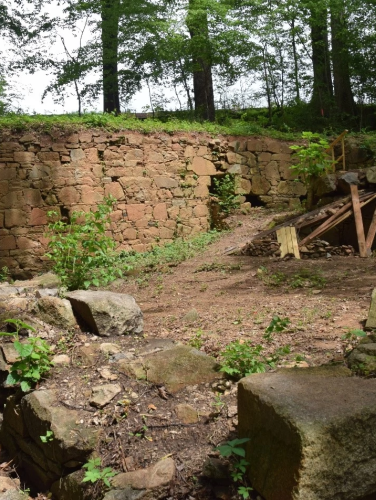
Isaac Newton Alexander Mill Ruin
(ca. 1858)
The Alexander Mill Ruin is the last remnant of what was Mecklenburg County’s first mill to process cottonseed oil.
2416 Colony Rd, Charlotte, NC 28209
In 1857, Isaac Newton Alexander (1808-1892), a farmer and native of Mecklenburg County’s Clear Creek community, purchased a large tract of land along Sugar Creek and Little Sugar Creek (now Briar Creek) in the Sharon section of the county. There, as part of his new farm, he constructed a water-powered grist mill – a two-story frame building resting upon a rock foundation – to serve the farmers of the surrounding countryside. Alexander did not operate the mill himself, but instead employed millers to oversee the gathering and grinding of grain into flour and meal.
Property Quick Links
Alexander was more directly involved with his own agricultural operations, for which he actively used enslaved labor. The 1830 federal census indicates that Alexander owned at least twenty enslaved persons, of whom seven were children under the age of ten. That number decreased to four enslaved persons according to the 1840 census, most likely due to Alexander’s role as the executor of the estate of his father, Charles Taylor Alexander (1764-1828). At the time of his death, the senior Alexander had three minor heirs, most likely leaving Isaac in possession of the enslaved persons bequeathed to his young siblings until they reached the age of majority and could legally claim their bequests. Per the slave schedule of the 1850 census, Isaac retained ownership of seven enslaved individuals. There is no evidence to suggest that enslaved labor was used in the operation of the mill.
The Isaac Newton Alexander Mill quickly became a hub of local activity. As late as 1880, the mill was in full operation, not only processing grain but also producing peanut oil, castor bean oil, and – a first for Mecklenburg County – cottonseed oil. By the late 1880s and 1890s, more advanced manufacturing processes improved the efficiency of local mills, including a roller mill in Dilworth, thereby rendering the Isaac Newton Alexander Mill obsolete. The old building fell silent. In August 1896, the Charlotte Observer reported that heavy rains had washed away the dam at Alexander mill.
Isaac Alexander, a long-time member and elder at Sharon Presbyterian Church, was buried in the church’s cemetery beside his wife Caroline Morrison Alexander (1825-1863), whom he had wed in 1845. Their son Cyrus Morrison Alexander (1854-1947), who had been associated with the mill operation, lived on the property until his death in 1947.
Today, only remnants of the complex survive. The mill pond once extended northward on Briar Creek, covering most of what is now the Myers Park Country Club golf course. The rock dam stood nearly fifteen feet high. Above the remains of the mill, traces of the flume or rock-lined trench that once brought water to the overshot wheel that powered the grinding apparatus is still visible. The dressed millstones (including both the runner stone and the bedstones) are extant but were moved in 1969 to a spot near the entrance to the adjacent Myers Park High School.

